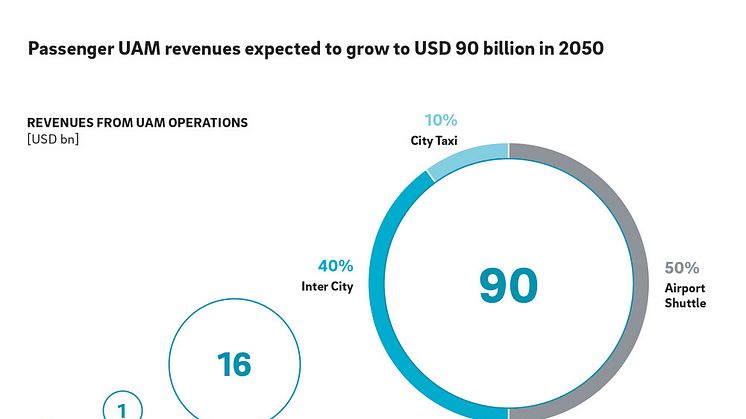
Press release -
The traffic of the future is taking off: Air taxis open up huge market potential
- Market volume of USD 90 billion a year and 160,000 air taxis expected by 2050
- Investments increase more than twenty-fold in the first half of 2020 compared to 2016 – despite corona crisis
- More than 110 cities around the world are working on Urban Air Mobility solutions
Munich, November 2020: In the coming years, air taxis will supplement private transport in urban areas. The first cities are already testing and planning this future: Demo flights have been conducted in Guangzhou, China, since 2018; the first aircraft are scheduled to transport people around the Olympic games in Paris, France, in 2024; and test flights are soon to be performed in Dallas, USA. The segment of manned Urban Air Mobility (UAM), or the expansion of urban transport systems into the airspace, is expected to reach an annual market potential of USD 90 billion by 2050. This is shown by Roland Berger in their latest study "Urban Air Mobility - USD 90 billion of potential: How to capture a share of the air taxi market”.
"We estimate that there will be about 160,000 commercial air taxis in the air by 2050," predicts Manfred Hader, Partner at Roland Berger. "Companies that produce cars, planes or helicopters today, as well as newcomers, can tap into a large market if they position themselves accordingly in the coming years.” Roland Berger's experts expect dynamic growth, especially between 2030 and 2050.

More than 110 cities worldwide are pursuing Urban Air Mobility projects
There are already more than 110 passenger UAM projects in cities around the world. Half of these are from Europe. Startups and established companies (manufacturers of aircraft, helicopters and vehicles) are developing air taxis and services for various sectors.
Even the corona pandemic, which has shocked large parts of the global economy and the traditional aviation industry in recent months, could not ultimately harm the rise of UAM: In the first half of 2020, investments in startups in this sector totaled USD 907 million – significantly more than in the whole of 2016 (approximately USD 40 million).
Currently two developments are giving the industry a boost. "Public acceptance of the technology is growing with every test flight and the regulatory authorities in Europe and the US are now dealing with the issue so seriously that legal hurdles can be overcome in the foreseeable future," says Dr. Stephan Baur, Principal at Roland Berger.
Looking to a promising future
In order to generate valid figures on future development, the authors of the study collected data from 1,200 major cities and cumulated them into four business model archetypes. They conclude that three different areas of application can be identified for the future: City Taxis with a range of 15 to 50 kilometers, Airport Shuttles with the same range and Inter City flights that can cover distances of up to 250 kilometers. The industry is therefore likely to specialize in roughly equal parts in the production of three different types (36% City Taxi, 35% Airport Shuttle, 29% Inter City).
However, the margins that can be achieved with these respective air taxis differ significantly: "By 2050, Airport Shuttle and Inter City services together will take the lion's share, about 90% of revenues," says Manfred Hader. As early as around 2025 the first providers will enter the market and offer these services. "As a result, we expect a transition to a premium model of public transport in which UAM services will become increasingly similar to today's taxi services".
But not only air taxi manufacturers will get a piece of the 90-billion-dollar pie. An entire ecosystem is growing around UAM. As a result, the market will become more disparate and lead to a number of different business models in various sectors. "It goes far beyond the pure air taxi – the market is growing alongside the infrastructure, which includes airfields, services, flight operations, ticket brokerage and repairs," says Dr. Stephan Baur. "At the moment we assume that air taxi manufacturers – similar to the automotive industry – will initially dominate the market. In any case, companies must clearly position themselves in this new ecosystem".
Topics
Categories
Roland Berger, founded in 1967, is the only leading global consultancy of German heritage and European origin. With 2,400 employees working from 35 countries, we have successful operations in all major international markets. Our 52 offices are located in the key global business hubs. The consultancy is an independent partnership owned exclusively by 250 Partners.




